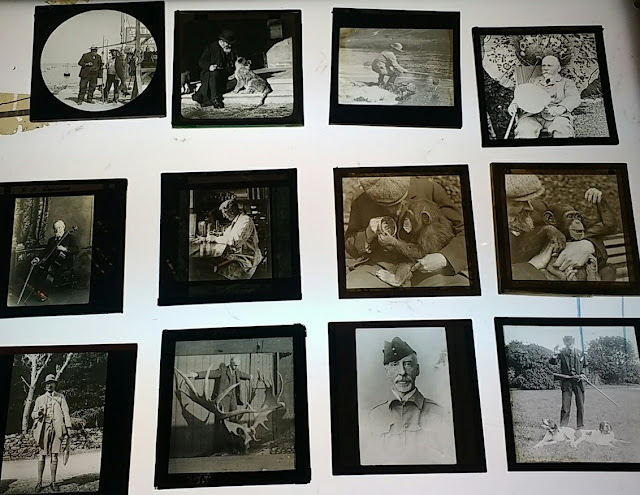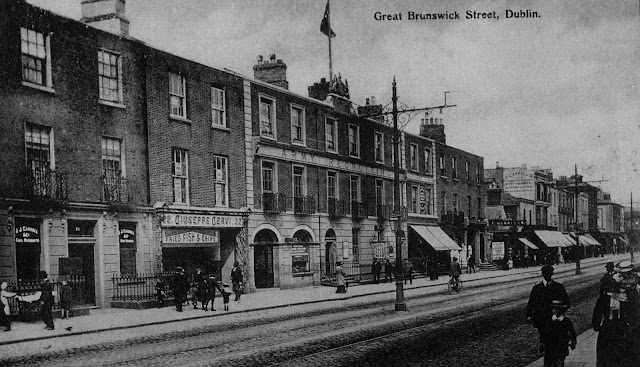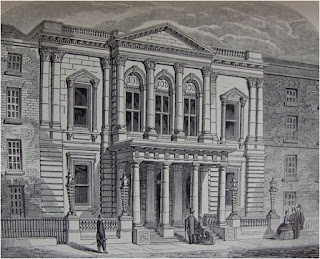The early years of the Dublin Biological Club
Last night the Dublin Biological Club held their annual dinner in the College, this inspired me to do some research into the early history of the Club, whose
archive we hold in the Heritage Centre.
The club was inaugurated in Room No. 30 of Trinity College Dublin on 6 January 1872. There were originally 14 members, and from these a secretary and treasurer were selected. The subscription was fixed at 10 shillings a year. As the minutes of the first meeting record ‘the object of the club shall be to consider the morbid and healthy condition of animal and vegetable life’. Meetings were originally to be held on Saturday evenings, but this was changed to Friday ‘chiefly because of Saturday being a very usual night for dinner parties’.
 |
| Glass slides of some early members of the Dublin Biological Club (DBC/9) |
Arthur Wynne Foot, one of the founding members, describes the early years of the club as being ‘passed with the careless indifference of youth’. He records that the amiability of the club’s meetings in Trinity attracted the notice of passing students who
‘were much exercised in mind as to the nature and object of our assembly. The company seemed too amiable for the meeting to have a political complexion, and not sufficiently dignified to be a branch of the philosophical or theological societies. Some suggested it was a gastronomic sodality, others held it was a vivisection club. It was rumoured among the jibs through Botany Bay that the resurrectionists in No. 30 had been seen handling brains, livers, and kidneys from one to another, and head saying they were exquisite, and also filling pipes and drinking beer with unwashed hands round a table covered with dishes and trays full of human entrails. Some of them thought it wrong that the provost should be kept a moment longer in ignorance of this state of things.’
As the Club's occasional expenses books shows beer was the only refreshment supplied. Wynne Foot records that the beer was a cask of draught light ale from Greenwood & Pim Brewery, of Harrold’s Cross. It was kept in a small closet in the room, with the club’s coal supply.
By 1874 there were 30 members and the room in TCD was much too small for the meetings, after much searching the club moved to a large room in 212 Great Brunswick Street, over Clarendon’s riding school. Brunswick Street presented some problems that had not been present when the meeting where held in Trinity, one being the disposal of morbid specimens. On occasions members left these behind, a practice not appreciated by the Association of the Amalgamated Ironmongers’ Assistants who met in the room on the following night.
 |
| Great Brunswick Street, early 20th century (source) |
Various rule changes were introduced to the club in the 1870s including one fining those members who didn’t present a paper in their allotted turn. This ‘never raised much’ for the club, but in 1878 one member offered half-a-dozen bottles of best champagne in lieu of the fine, an offer which was accepted ‘without a dissentient voice’.
Towards the end of the 1870s the idea of an annual dinner to be held at Bohernabreena in the Dublin Mountains was accepted. After dinner entertainments included flying kites, playing quoits and firing a .22 bore rifle at empty champagne bottles. After the entertainment the members made their way down the hill ‘on the comparatively safe side-car or on the very dangerous bicycle’.
 |
| 6 Kildare Street, c.1870 |
In 1881 the club moved to RCPI’s building at 6 Kildare Street for its meeting, although the move did not start well as at the first meeting here ‘a heavy mass of cornice fell on an evening meeting, and several of the members had a narrow escape from being hurt’. Wynne Foot notes two marked changes on the move to Kildare Street, firstly in the variety of refreshments offered and secondly in the exhibition of living specimens. The first seems most important and he records that
‘the original light ale is replace now by been in variety (Larger, Bass, et); mineral waters in variety; coffee, cigars, cigarettes, snuff, in addition to cut tobacco of the choicest description’.
One of the first living specimens exhibited was by Dr Swanzy, he showed a young women who he had successfully treated with a skin graft for extensive ectropion of the upper eyelid after a burn. Other notable presentations include one by Dr Macan on the use of carbolic solution in antiseptic treatment at the Rotunda, and a visiting lecture from a Dr Carte on six cases on hanging. Crime seems to have been of interest to the members as the following year William Stokes exhibited the head of a man who had committed murder and then suicide. He had cut his throat with a small pen knife exposing the posterior wall of the pharynx.
Rule XXI of the club, the guillotine rule, was introduced as a way to encourage attendance. Anyone not making at least three meetings a year were removed from the club. In 1892 Dr Wynne Foot fell foul of this rule, but was saved by a vote to make him an honorary member ‘as the father of the club’. In the same year, as the club celebrated its 20th birthday, Arthur Wynne Foot’s account of the club’s history was printed at the clubs expense.
All quotes are taken from Arthur Wynne Foot’s Reminiscences of the Dublin Biological Club (Dublin: Fannin & Co, 1892)